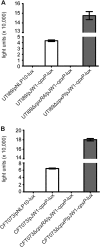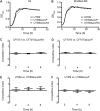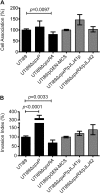The Cpx stress response system potentiates the fitness and virulence of uropathogenic Escherichia coli
- PMID: 23429541
- PMCID: PMC3647988
- DOI: 10.1128/IAI.01213-12
The Cpx stress response system potentiates the fitness and virulence of uropathogenic Escherichia coli
Abstract
Strains of uropathogenic Escherichia coli (UPEC) are the primary cause of urinary tract infections, representing one of the most widespread and successful groups of pathogens on the planet. To colonize and persist within the urinary tract, UPEC must be able to sense and respond appropriately to environmental stresses, many of which can compromise the bacterial envelope. The Cpx two-component envelope stress response system is comprised of the inner membrane histidine kinase CpxA, the cytosolic response regulator CpxR, and the periplasmic auxiliary factor CpxP. Here, by using deletion mutants along with mouse and zebrafish infection models, we show that the Cpx system is critical to the fitness and virulence of two reference UPEC strains, the cystitis isolate UTI89 and the urosepsis isolate CFT073. Specifically, deletion of the cpxRA operon impaired the ability of UTI89 to colonize the murine bladder and greatly reduced the virulence of CFT073 during both systemic and localized infections within zebrafish embryos. These defects coincided with diminished host cell invasion by UTI89 and increased sensitivity of both strains to complement-mediated killing and the aminoglycoside antibiotic amikacin. Results obtained with the cpxP deletion mutants were more complicated, indicating variable strain-dependent and niche-specific requirements for this well-conserved auxiliary factor.
Figures






References
-
- Foxman B. 2010. The epidemiology of urinary tract infection. Nature Rev. Urol. 7:653–660 - PubMed
-
- Dhakal BK, Kulesus RR, Mulvey MA. 2008. Mechanisms and consequences of bladder cell invasion by uropathogenic Escherichia coli. Eur. J. Clin. Invest. 38(Suppl. 2):2–11 - PubMed
-
- Hunstad DA, Justice SS. 2010. Intracellular lifestyles and immune evasion strategies of uropathogenic Escherichia coli. Annu. Rev. Microbiol. 64:203–221 - PubMed
-
- Jorgensen I, Seed PC. 2012. How to make it in the urinary tract: a tutorial by Escherichia coli. PLoS Pathog. 8:e1002907 doi:10.1371/journal.ppat.1002907 - DOI - PMC - PubMed
Publication types
MeSH terms
Substances
Grants and funding
LinkOut - more resources
Full Text Sources
Other Literature Sources

